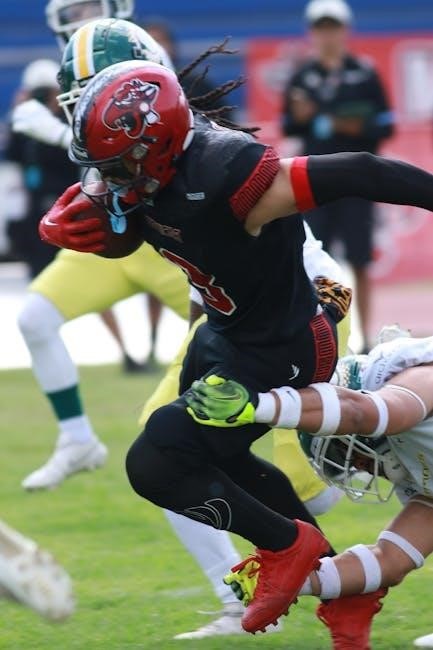The Split Back Shotgun offense, a dynamic strategy, is explained in this playbook PDF. It provides a balanced attack, useful for coaches seeking versatility and adaptability.
What is the Split Back Shotgun Formation?
The Split Back Shotgun formation is an offensive football strategy that combines elements of both the shotgun formation and the split backfield. It typically features the quarterback positioned several yards behind the center in a shotgun stance, allowing for a wider field of vision and quicker passing opportunities. Unlike a traditional single-back shotgun, this formation employs two running backs aligned horizontally behind the quarterback, creating a balanced attack capable of both running and passing plays.
This dual-threat backfield provides multiple advantages, including enhanced blocking schemes, diverse running options, and increased deception. The split backs can be utilized for inside handoffs, outside sweeps, or option plays, forcing the defense to account for both potential running lanes. Furthermore, the formation allows for creative passing concepts, such as play-action passes and screen passes, where the running backs can be effectively used as receivers.
The Split Back Shotgun is also effective at creating favorable matchups and exploiting defensive weaknesses.
Key Principles of the Split Back Shotgun Offense
The Split Back Shotgun offense revolves around several core principles that dictate its success. First, balance is paramount. The formation aims to create a credible threat in both the running and passing games, preventing defenses from keying on a single aspect of the offense. This is achieved through the dual-back setup, which allows for diverse running schemes and pass protection options. Second, versatility is crucial. The offense must be able to adapt to various defensive alignments and exploit weaknesses through pre-snap reads and post-snap adjustments.
Third, deception plays a significant role. The split backs can be used to create misdirection and confusion for the defense, opening up running lanes or creating favorable passing matchups. Play-action passes, option plays, and pre-snap motion are all valuable tools for deceiving the defense. Fourth, execution is essential. The success of the Split Back Shotgun offense relies on the precision and timing of each player, particularly the quarterback and running backs.
Finally, personnel is critical.

Personnel Considerations for Split Back Shotgun
Selecting the right players is crucial. Quarterbacks need decision-making skills. Running backs must display versatility. Linemen should be agile. Receivers must be able to create separation. The right mix maximizes effectiveness.
Ideal Quarterback Attributes
For the Split Back Shotgun offense, the quarterback’s attributes are paramount to its success. Beyond possessing a strong arm, the quarterback must exhibit exceptional decision-making skills. Quick reads of defensive alignments are crucial for exploiting mismatches and making sound judgments on run-pass options, as demonstrated by successful teams utilizing similar systems.
Accuracy is key; intermediate and short throws must be precise for consistent gains. Furthermore, the quarterback’s mobility cannot be overlooked. The ability to evade pressure, extend plays, and execute designed quarterback runs adds a dynamic element to the offense, forcing defenses to account for an extra threat. A high football IQ allows the quarterback to understand play concepts, anticipate defensive reactions, and make necessary adjustments at the line of scrimmage.
Finally, leadership is vital, the quarterback must command respect, inspire confidence, and effectively communicate with teammates, ensuring everyone operates in sync. These attributes combine to form the ideal quarterback for a potent Split Back Shotgun attack.
Running Back Requirements
The Split Back Shotgun offense places significant demands on its running backs. Dual-threat capabilities are highly valued; each back must be adept at both running and receiving, creating matchup problems for defenses. Speed and agility are essential for exploiting running lanes and evading tacklers. The ability to make quick cuts and accelerate through openings is crucial for maximizing yardage on inside and outside runs.
Strong hands and reliable pass-catching skills are necessary for executing screen passes and routes out of the backfield. Blocking proficiency is also important; running backs must be capable of picking up blitzes and providing pass protection for the quarterback. Furthermore, a high level of football intelligence is beneficial for understanding play concepts, reading defensive schemes, and making adjustments on the fly.
Durability and stamina are vital for enduring the physical demands of carrying the ball and blocking throughout the game. Ultimately, successful running backs in the Split Back Shotgun offense possess a blend of athleticism, skill, and mental acuity.
Running Plays from the Split Back Shotgun
The Split Back Shotgun provides diverse running options. This playbook outlines inside handoffs, outside sweeps, and option plays, maximizing the potential of athletic running backs and strategic play-calling.
Inside Handoffs and Dives
Inside handoffs and dives in the Split Back Shotgun offense are designed to exploit the interior of the defensive line; These plays emphasize quick hitting and decisive running. A critical element is the offensive line’s ability to create immediate gaps. The center and guards must work in unison to establish a push at the point of attack.
Running backs should aim to hit the designated hole with speed and determination. The play’s success depends on the back’s ability to read blocks and make quick decisions. A well-executed inside handoff or dive can gain crucial yards and keep the defense honest.
These plays are most effective when the defense is expecting outside runs or pass plays. They provide a change of pace and can help wear down the defensive line over time. Consistency and proper execution are key to maximizing the effectiveness of inside running plays from the Split Back Shotgun.
Outside Runs and Sweeps
Outside runs and sweeps from the Split Back Shotgun formation aim to attack the perimeter of the defense. These plays require speed, agility, and precise blocking. The offensive line, particularly the tackles and guards, must be able to pull and lead the running back around the edge.
Wide receivers also play a crucial role in blocking defensive backs and creating running lanes. Timing and coordination are essential for the success of these plays. The running back must be patient, following his blockers and waiting for an opening to burst through.
Option plays can be incorporated into the outside run game, giving the quarterback the choice to hand off or keep the ball based on the defensive alignment. A successful outside run or sweep can result in significant yardage and put pressure on the defense to adjust.
Option Plays and QB Keepers
Option plays and quarterback keepers add a dynamic element to the Split Back Shotgun offense. These plays rely on the quarterback’s decision-making ability and athleticism. The quarterback reads the defensive end or linebacker, determining whether to hand the ball off to the running back or keep it himself.
QB keepers can catch the defense off guard, especially if they are focused on stopping the running backs. The quarterback must be a threat as a runner to make these plays effective. Proper execution requires precise timing and a clear understanding of the defensive reads.
Option routes for receivers can also be incorporated, giving the quarterback multiple choices based on the coverage. These plays can create confusion for the defense and lead to big gains.

Passing Plays from the Split Back Shotgun
Passing plays are integral to the Split Back Shotgun. These plays utilize the formation’s versatility to create favorable matchups and exploit defensive weaknesses through varied passing concepts.
Play Action Passing Concepts
Play action passing from the Split Back Shotgun aims to capitalize on defenses anticipating a run. By faking a handoff to one of the running backs, the quarterback can draw linebackers and safeties closer to the line of scrimmage, creating open passing lanes downfield. Common play action concepts include:
- Bootlegs: The quarterback fakes a handoff and rolls out to one side, giving him the option to run or pass to a receiver running a crossing route or a route to the flat.
- PA Deep Shots: After faking the run, the quarterback looks to throw deep to a receiver running a post, corner, or go route, taking advantage of single coverage created by the run fake.
- Quick Outs: The quarterback fakes the run and quickly throws to a receiver running an out route, providing a safe and reliable option for a short gain.
Effective play action requires strong acting from the quarterback and running backs to sell the run, as well as precise timing and route running from the receivers. These concepts are designed to keep defenses honest and prevent them from keying in on the run.
Utilizing Split Backs in the Pass Game
The split back formation offers unique opportunities in the passing game. Both backs can be utilized as receiving threats, creating mismatches and opening up passing lanes. Here are a few ways to incorporate them:
- Swing Routes: One or both backs can run swing routes to the flats, providing a quick outlet for the quarterback and forcing defenses to account for their speed in space.
- Wheel Routes: A back can run a wheel route from the backfield, creating a vertical threat and potentially isolating a linebacker or safety in coverage.
- Check-Down Options: The backs can serve as check-down options for the quarterback when the primary receivers are covered, offering a safe and reliable target for a short gain.
- Screen Passes: Running backs are excellent candidates for screen passes. The quarterback can fake a deeper throw, then quickly dump the ball off to a running back behind a wall of blockers.
By effectively utilizing the split backs in the passing game, offenses can keep defenses guessing and exploit their versatility.

Advantages of the Split Back Shotgun Offense
The Split Back Shotgun offense provides numerous advantages for teams looking to create a versatile and explosive attack. Here are some key benefits:
- Balanced Attack: The formation allows for a balanced approach, with equal threats in both the running and passing game.
- Multiple Options: Defenses must account for both running backs, creating indecision and opening up opportunities for mismatches.
- Improved Pass Protection: The shotgun formation provides the quarterback with additional time and space to make reads and deliver the ball.
- Versatile Play Calling: Coaches can utilize a wide range of plays, including inside runs, outside runs, play-action passes, and screen passes.
- Enhanced Deception: The split back alignment can create confusion for defenses, making it difficult to anticipate the direction of the play.
This offensive scheme’s adaptability makes it a valuable asset for teams seeking to maximize their offensive potential and keep defenses off balance.
Disadvantages of the Split Back Shotgun Offense
While the Split Back Shotgun offense offers many advantages, it also presents some challenges that coaches must consider.
- Demands on Quarterback: The quarterback must be able to make quick reads and accurate throws from the shotgun formation.
- Requires Athletic Running Backs: Both running backs need to be versatile, capable of running inside, outside, and catching passes.
- Pass Protection Vulnerabilities: If the offensive line struggles with pass protection, the quarterback can be exposed to pressure.
- Susceptible to Blitzes: Defenses can exploit the shotgun formation with well-timed blitzes, disrupting the quarterback’s timing.
- Limited Power Running Game: The formation may not be ideal for teams that rely heavily on a power running game.
Successful implementation requires careful personnel selection, thorough practice, and adjustments based on defensive schemes.

Examples of Split Back Shotgun Playbooks
Several examples of Split Back Shotgun playbooks are available for coaches looking to implement this offense. One notable example includes the “Eagle Split Back Playbook,” which outlines formations like Slot Right and Slot Left, detailing various plays for each. These playbooks often incorporate a numbering system for identifying player positions and holes in the offensive line.
Another example showcases youth football playbooks focused on a series of six plays, emphasizing simplicity and effectiveness. Some resources combine the shotgun and single back offenses into a hybrid system, providing a more versatile approach. Coaches can adapt these playbooks to suit their team’s specific strengths and weaknesses.
These resources offer a foundation for building a successful Split Back Shotgun offense.

Leave a Reply
You must be logged in to post a comment.